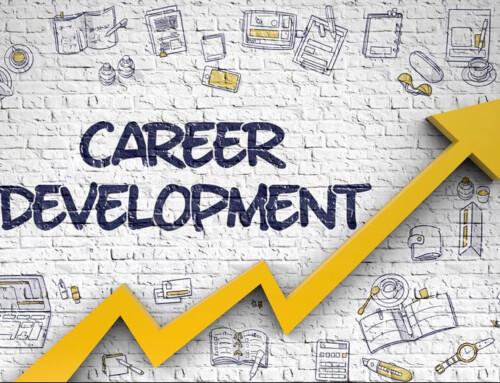The advancement of existing technology and the unveiling of new technology seem to move at the speed of light these days. While many tools made possible by today’s technology are beneficial, keeping up with it as a business leader can feel daunting. How can you stay ahead of the technology curve to navigate the ever-changing technology landscape?
Lateral and vertical thinking offer an intriguing and entirely achievable solution. By applying both ways of approaching a problem to technology trends, leaders can learn to implement evolving technology with confidence while fostering a culture of curiosity, adaptability, and team empowerment.
WHAT IS VERTICAL THINKING?
Rooted in tried-and-true practices, problem-solving through vertical thinking relies on a linear process. The journey from point A to point B and from the beginning to the end of the process is clearly defined and does not deviate from the planned route. It is highly structured and well organized.
A logical and systematic approach works best when applied to well-defined problems. Vertical thinkers work through problems methodically, using their keen analytical skills to simplify complex problems into manageable steps they can complete.
A case study in vertical thinking is the Apollo 13 mission, which occurred in 1970. After an oxygen tank exploded, the spacecraft’s power and oxygen supply was crippled, leaving the space crew essentially stranded 200,000 miles from Earth. Working with NASA’s mission control, solutions for power, water, and carbon dioxide removal were improvised with supplies available in the spacecraft. While Apollo 13’s mission to the moon was cut short, the crew landed safely in the Pacific Ocean. Despite the mission’s failure, safety protocols that impacted future explorations into space were implemented. (1, 2, 3, 4, 5, 6, 7)
A defined problem and the need to solve it within the specific confines of limited options and/or resources make Apollo 13 a perfect example of vertical thinking. Each part of the solution had to be clearly defined, and no step could be missed, or the solution would fail.
WHAT IS LATERAL THINKING?
If vertical thinking leans on traditional, established problem-solving concepts and follows a linear process, lateral thinking breaks through conventional methods and follows no particular order. Lateral thinkers seek connections that are not obvious to unearth new and innovative ways to solve problems.
Lateral thinking can also be described as horizontal thinking. If you’re looking for the perfect illustration to describe lateral thinking, nothing could be more perfect than a sunset along the horizon. Picture a sun with rays spreading out in different directions and various hues of colors. It’s easy to envision a color wheel and the limitless combination of colors!
When people use the lateral thinking approach, they view a problem or dilemma with many different routes that could lead to the solution. There is not one single “right” answer; rather, there are many that lead to a favorable outcome. People who think laterally tend to be creative, open to embracing new ideas and strategies, and think outside the box.
PUTTING LATERAL AND VERTICAL THINKING INTO ACTION
Vertical and lateral thinking each have strengths and benefits. In this way, they make up two halves of a whole. So, when implementing technology into your company’s work, it makes sense to use both approaches.
Take the current state of artificial intelligence (AI) integration. Currently, AI’s customer experience (CX) interactions still require some level of human participation. In other words, AI still needs us; it has not yet reached the point of being autonomous and might never gain this ability.
The dilemma in this scenario is determining how to fully take advantage of AI’s ability to execute certain interactions with customers while maintaining enough human involvement to ensure the initiatives around customer experience are successful. In other words, you want customers to feel like they are having an authentic experience with an organization that is tech-savvy yet makes human representatives available when customers need them.
Vertical Thinking Approach
Using the framework of a structured and logical process that follows a delineated process, create an outline of your plan of action. It might start with collecting data (in the form of statistics and reports from studies) on organizations that successfully leveraged AI to facilitate partially automated and partially human customer experiences. Conversely, look for data on endeavors in this area that failed. You want to know precisely what you should and should not do.
Analyze each proposed AI-driven, CX related project from start to finish and pose questions like:
- What AI tools will we use?
- How much AI versus human involvement is ideal for customer interaction?
- Where in this CX scenario does AI enhance the customer experience? Where does AI detract from it?
- How much human involvement do we need to create a positive, easy, and efficient customer experience?
Make sure you have questions and answers for every part of the process that a customer might encounter. Map out the entire process from start to finish, leaving no stone unturned.
Lateral Thinking Approach
It’s important to note that the customer experience will not always be linear. It will often not follow any set order, as a customer could interact with your AI technology for many reasons. They could be a new customer who needs basic information or a long-established customer who already knows much about your offerings. With its nimble approach and creative strengths, lateral thinking is perfect for realistically visualizing how a customer might navigate your website.
Gather team members from your organization who hold different roles, work in other departments, and are at different levels in the company hierarchy. The goal is to solicit a large variety of feedback about the proposed customer experience and get their ideas on how to make it seamless by incorporating AI with a human presence. Doing so is crucial for understanding what customers might run into from an expansive sampling of people. Plus, you improve your chances of getting job role-specific ideas you can apply to CX efforts.
This is also an ideal exercise for an offsite meeting, as working together fosters team building and helps forge bonds between teammates. You will also get to observe the areas where each attendee thrives.
Make the meeting a brainstorming session to allow for more spontaneous creativity. However, don’t stray too far from the more formal elements of an agenda to ensure that the meeting is productive. One way to accomplish both is to allow for brainstorming before the actual meeting and bring the concepts into the meeting. Another is to allow for breakout sessions where opposing perspectives can be constructively discussed. Invite attendees to share their insight and ensure someone is recording it.
WHY THIS DUAL APPROACH WORKS
In a genuine sense, vertical and lateral thinking provide something that the other one lacks. Combining the two schools of thought when applying AI to CX projects gives your team a strong chance of creating a positive experience that can help improve customer retention. More importantly, as a leader, you have the confidence to implement evolving technology while empowering your team to be curious, innovative, and adaptable.
For more information about planning a corporate meeting where attendees can brainstorm successfully, contact Gavel International to learn more about how our expertise can help your organization achieve this goal.
_____________
SOURCES
- https://www.quora.com/What-was-the-biggest-problem-the-astronauts-aboard-Apollo-13-were-facing
- https://www.linkedin.com/pulse/solving-problems-fast-effective-apollo-13-approach-marc-erras
- https://www.quora.com/How-did-Apollo-13-astronauts-fix-the-problem-of-the-oxygen-leaking
- https://www.nasa.gov/missions/apollo/apollo-13-mission-details/
- https://www.history.com/news/apollo-13-what-went-wrong
- https://www.nasa.gov/missions/apollo/apollo-13-the-successful-failure/
- https://www.nasa.gov/kennedy/
This article was last updated on April 24, 2025
- User-Generated Content in Marketing Wins Audience Trust - September 15, 2025
- 7 Ways to Elevate Culinary Experiences at Corporate Events - September 1, 2025
- 4 Reasons Why Corporate Training Programs Are Worth the Investment - August 4, 2025






